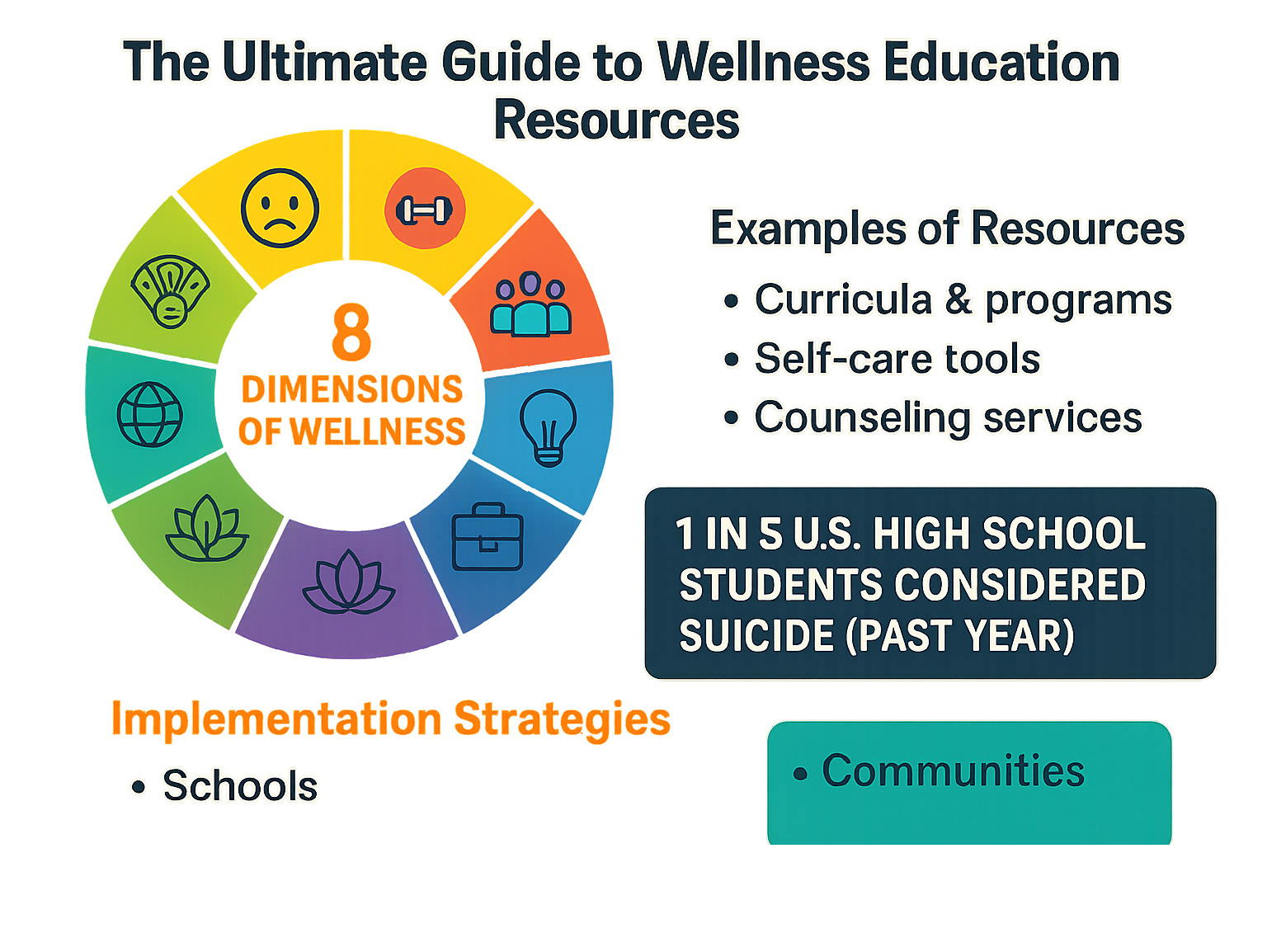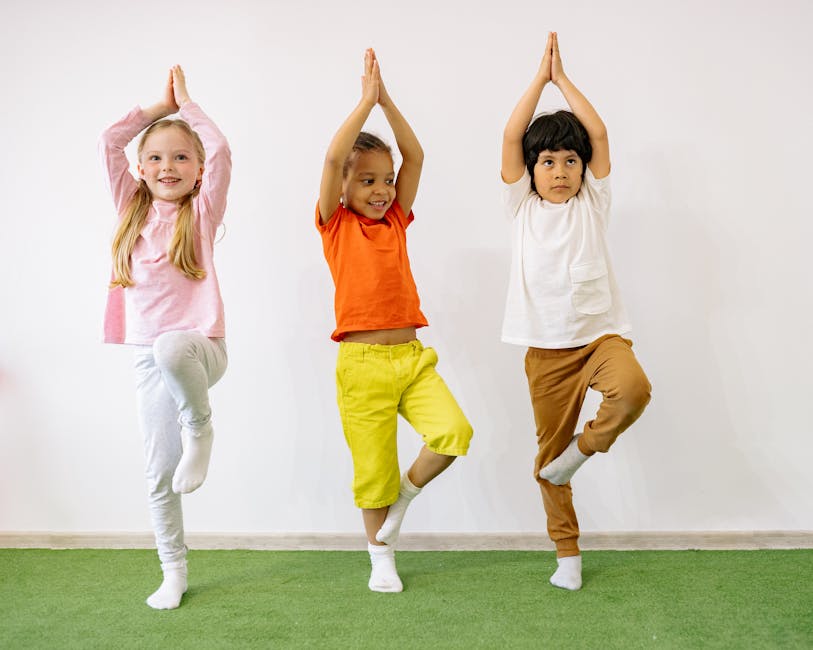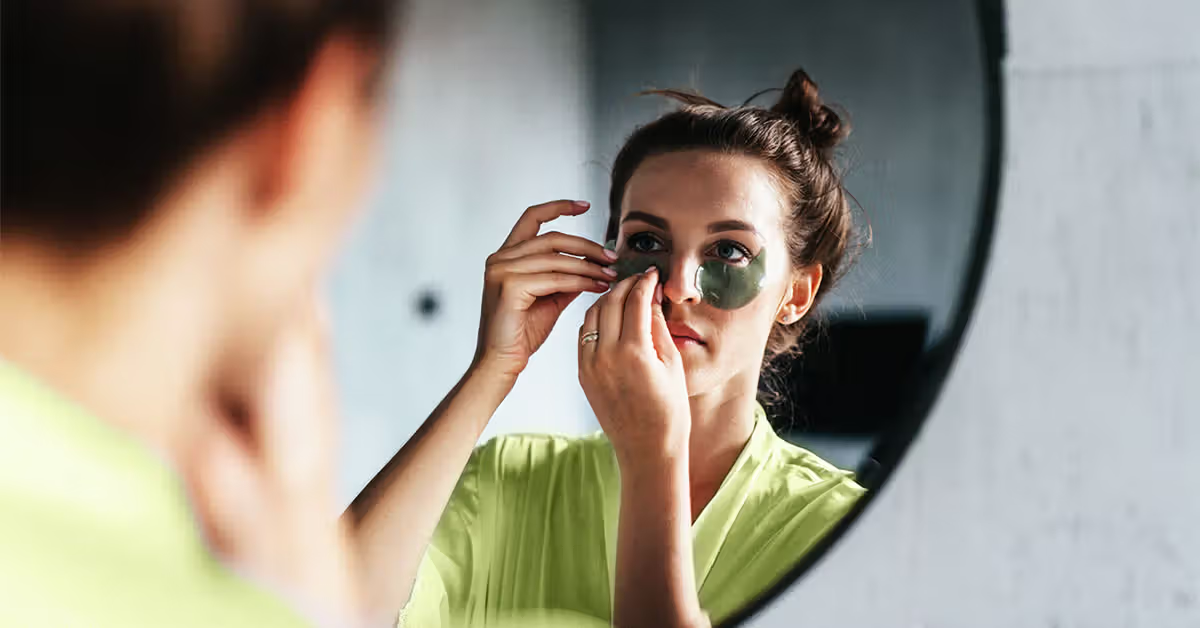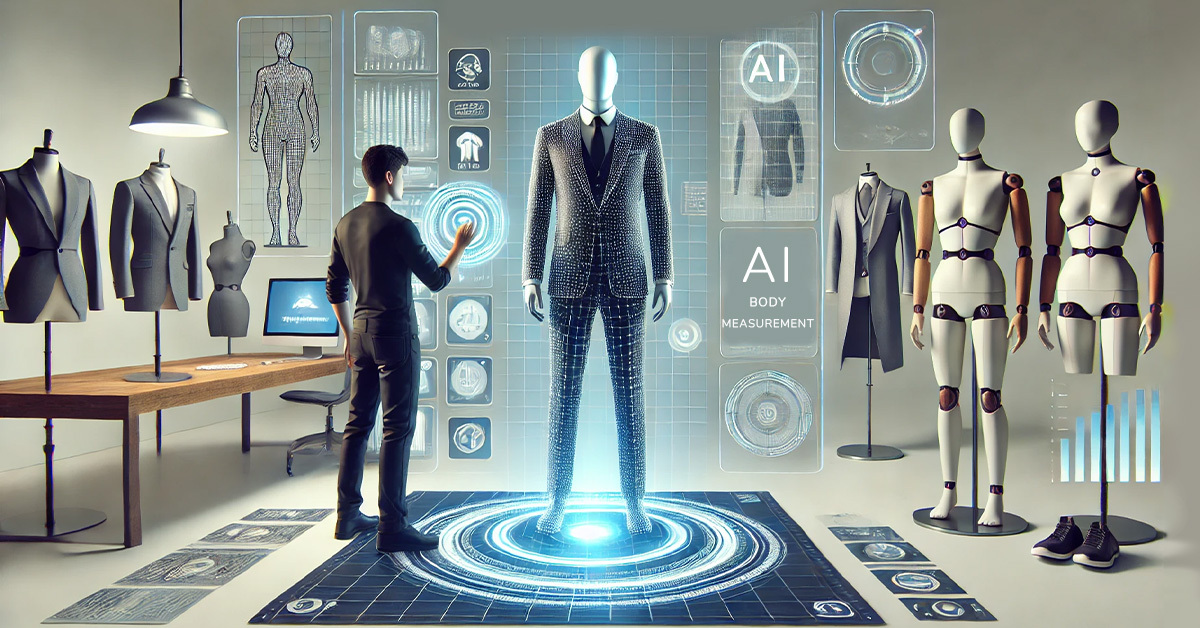Understanding Wellness Education Resources
Wellness education resources are tools, programs, and materials designed to support mental, physical, emotional, and social wellbeing in schools, communities, and homes. If you’re looking for quality wellness education resources, here’s what you need to know:
| Type of Resource | Examples | Best For |
|---|---|---|
| Curriculum & Lesson Plans | Project School Wellness, Generation Wellness Toolkit | Schools, educators |
| Self-Assessment Tools | Wellness Compass assessments, stress quizzes | Individuals, counselors |
| Digital Platforms | Wellness Education Lab (WEL), Change to Chill | Teens, parents, educators |
| Mindfulness & Stress Relief | Breathing exercises, guided imagery | All ages, immediate use |
| Nutrition & Physical Wellness | Nutrition for Healing guides | Health classes, families |
Nearly 1 in 5 students have seriously considered suicide in the past year, according to the U.S. Department of Health & Human Services. This alarming statistic highlights why wellness education is no longer optional—it’s essential.
Wellness education goes beyond traditional health classes. It equips students, educators, and communities with practical skills to manage stress, build resilience, and develop healthy habits that last a lifetime.
As one educator put it: “Mind-body activities can help people tolerate discomfort better, help teach self-regulation, reduce meltdowns, lower stress, and create focus.”
What makes these resources valuable is their ability to address the whole person. The best wellness education resources don’t just focus on physical health—they integrate emotional regulation, social connections, and environmental awareness into a comprehensive approach.
Whether you’re a teacher looking to support struggling students, a parent seeking ways to build resilience at home, or an individual wanting to improve your own wellbeing practices, the right resources can make all the difference.

What You’ll Learn
In this comprehensive guide, we’ll explore the full spectrum of wellness education resources available today. You’ll find:
- What wellness education is and why it’s crucial for today’s students and educators
- The eight core dimensions of wellness and resources for each
- Evidence-based programs that are making a difference in schools and communities
- Practical tools you can implement immediately—many at no cost
- How to integrate wellness education into daily routines
- Methods for measuring progress and ensuring equity
- Answers to commonly asked questions about wellness implementation
By the end of this guide, you’ll have practical takeaways you can use to improve wellness in your school, home, or personal life, regardless of your starting point or budget.
What Is Wellness Education & Why It Matters
Imagine a classroom where students aren’t just learning math and reading, but also how to breathe through anxiety, understand their emotions, and care for their whole selves. That’s the heart of wellness education—a comprehensive approach that nurtures not just the mind, but the entire person.
Unlike traditional health classes that might focus mainly on avoiding illness, wellness education resources accept a broader vision of thriving. They help students, educators, and families develop practices that support mental, emotional, physical, and social wellbeing all at once.
“If you give your body vibrant, healthy food it will help you become a vibrant, healthy human!” as the Nutrition for Healing Initiative beautifully puts it. This wisdom extends beyond just what we eat—it’s about nourishing every aspect of ourselves.
The stakes in this work couldn’t be higher. The sobering reality is that nearly one in five students have seriously considered suicide in the past year. This isn’t just a statistic—these are our children, sitting in classrooms, often suffering silently. This is why wellness education resources have become essential, not optional.
As Lyndsay Morris, founder of Generation Wellness, explains: “Stress, trauma, and uncertainty drastically impact learning, retention, and reaching our fullest potential. Cultivating connection and wellness for students, staff, and families is more important than ever.”
What makes these approaches so powerful is their focus on prevention rather than just intervention. By teaching students self-regulation techniques before crises occur, we build resilience muscles they’ll use throughout life. The scientific research on emotional regulation consistently shows that these skills can be taught, practiced, and strengthened over time.
Benefits for Students, Staff & Families
When schools accept quality wellness education resources, the positive ripples extend far beyond just “feeling better.” The research-backed benefits touch every corner of school and home life:
For our students, wellness education translates to concrete academic gains—improved grades, better attendance, and sharper focus during lessons. But it also shows up as fewer trips to the principal’s office, stronger friendships, and a remarkable ability to bounce back when life gets tough.
Educators experience their own change. Teachers who practice and teach wellness report less burnout and compassion fatigue. They enjoy their work more, miss fewer days, and develop classroom management approaches that feel less like constant firefighting and more like community building.
Families benefit too. When children bring home the language of emotions and needs, communication improves. Parents and children develop shared tools for handling stress, creating healthier home environments and stronger bonds.
One teacher summed it up perfectly: “This was such a blessing to me, this is a complete HEALTH package! The rubrics are great and the activities are amazing! This is all you need, no planning or creating!”
The Cost of Ignoring Wellness
When schools push wellness to the bottom of the priority list, the consequences ripple through the entire community. Mental health crises that might have been prevented require intensive intervention. Attendance drops as students struggle to manage overwhelming emotions. Behavior referrals climb as unaddressed needs express themselves through disruption.
For teachers, the cost is burnout and turnover. For healthcare systems, it’s rising expenses for preventable conditions. And most concerning of all, achievement gaps widen, particularly for our most vulnerable students.
The California School-Based Health Alliance puts it simply: “putting health care in schools makes sense for improving academic success.” The truth is, when basic wellness needs go unmet, even the most brilliant curriculum can’t reach a student who’s struggling just to make it through the day.
By investing in comprehensive wellness education resources, we’re not just adding one more thing to our educational plate—we’re creating the foundation that makes all other learning possible.
Wellness Education Resources: The 8 Core Dimensions
Comprehensive wellness extends beyond just physical and mental health. The National Wellness Institute and many leading wellness frameworks recognize eight core dimensions that, when balanced, contribute to holistic wellbeing:
Let’s explore quality wellness education resources for each dimension:
Emotional & Mental Health Wellness Education Resources
Emotional wellness involves understanding, expressing, and managing feelings in healthy ways. Key resources include:
Wellness Education Lab (WEL): This free, evidence-based mental health training suite offers three custom module versions for students (13+), parents/guardians, and educators. Each module takes approximately 45-60 minutes to complete, with progress saved automatically.
“Nearly 1 in 5 students had seriously considered attempting suicide in the last 12 months,” notes the U.S. Department of Health & Human Services. Resources like WEL directly address this crisis by increasing mental health literacy.
Change to Chill: This platform offers free online mental health resources specifically designed for teenagers. It includes a stress quiz that helps teens identify personalized stress-management techniques, along with mindfulness activities, guided imagery meditations, and resources for educators.
Trauma-Informed Practices: The Generation Wellness Toolkit includes over 100 trauma-informed tools organized by tier level (universal, targeted, and intensive support). These resources help educators recognize and respond appropriately to the impacts of trauma on learning and behavior.
A standout feature of quality emotional wellness resources is their practicality. As one resource states: “Ask yourself, what do I need right now?” This simple prompt encourages the self-awareness that forms the foundation of emotional regulation.
Physical Activity & Nutrition Resources
Physical wellness encompasses healthy eating, regular physical activity, adequate sleep, and avoiding harmful substances. Key resources include:
Project School Wellness: This comprehensive curriculum has served over a million students with ready-to-teach lesson plans on nutrition, fitness, and healthy habits. Teachers praise its “whole body wellness approach” that requires no additional planning or creation.
Nutrition for Healing Guide: This non-judgmental nutritional guide provides practical information on topics like:
– Understanding food labels and marketing claims
– The truth about sugar (added to 75% of grocery products!)
– Hydration (the human body is 60-80% water)
– Mindful eating practices
The World Health Organization recommends that only 5% of our daily calories should come from added sugars, but in many countries, consumption rates are double or triple this amount. Quality nutrition resources help students and families steer these challenges.
Physical Activity Integration: Resources like mind-body activities teach self-regulation while getting bodies moving. Examples include:
– Balloon Breath: inhaling deeply into the belly until it “fills a balloon,” then exhaling to “deflate” it
– Ocean Breath: inhaling through the nose, exhaling with a long “haa” sound
– Lion’s Breath: forceful exhalation with tongue out to release tension
These activities can be integrated into classroom transitions, brain breaks, or dedicated wellness time.
Social & Community Resources
Social wellness involves building and maintaining positive relationships and contributing to one’s community. Key resources include:
Wellness Compass Assessments: These self-assessment tools include 80 statements—10 for each of the eight wellness areas—custom for teens, parents, and adults. They help identify relationship strengths and growth areas.
Relationship Skills Curricula: Many comprehensive wellness programs include lessons on:
– Healthy vs. unhealthy relationships
– Effective communication
– Conflict resolution
– Boundary setting
– Community building
Peer Support Frameworks: Resources that train students to support one another create sustainable wellness cultures. The Mind Out Loud program, for example, empowers teens to recognize warning signs and connect peers with appropriate help.
As the Wellness Compass Initiative notes: “Whole-person wellness is best approached by integrating emotional, relational, spiritual, physical, organizational and vocational dimensions.”
Intellectual & Occupational Resources
Intellectual wellness involves lifelong learning, creativity, and critical thinking, while occupational wellness focuses on finding meaning and satisfaction in work. Key resources include:
Growth Mindset Materials: Resources that teach students about brain plasticity and the power of “yet” help build resilience and learning persistence.
Career Exploration Lessons: Project School Wellness offers a six-lesson career exploration bundle that helps students identify their values and interests while exploring career options beyond just salary considerations.
Lifelong Learning Frameworks: Quality wellness resources teach students how to be curious, ask good questions, and pursue knowledge throughout life—not just for grades or external rewards.
These resources are particularly valuable as they connect wellness to future success, helping students see the relevance of self-care to their long-term goals.
Spiritual & Environmental Resources
Spiritual wellness involves finding purpose and meaning, while environmental wellness focuses on creating and maintaining healthy surroundings. Key resources include:
Mindfulness Curricula: Programs like Generation Wellness teach grounding techniques such as:
– Body connection exercises
– Environmental scanning
– Sensation awareness
– Deepened breathing
Core Values Identification: The Project School Wellness values exploration bundle includes six lessons that help students identify and live according to their core values.
Green Beauty and Sustainability: Resources that teach environmental stewardship as part of wellness help students understand the connection between planetary and personal health.
“Real food doesn’t need an ingredient list; it IS the ingredient,” notes the Nutrition for Healing Initiative. This simple insight connects personal nutrition choices to larger environmental impacts.
Evidence-Based Programs & Practical Tools
With so many wellness education resources available, it can be challenging to identify which ones are truly evidence-based and effective. Here are some standout programs with strong research backing:
Free & Low-Cost Digital Platforms
Wellness Education Lab (WEL): This completely free mental health training suite is supported by the California Department of Education. It offers separate modules for students (13+), parents/guardians, and educators, with Spanish translation available for parent modules.
HealthPoweredKids: These resources teach children ages 3-14 about the mind-body connection through age-appropriate activities.
Hello4Health: This platform focuses on helping adults strengthen social connections, which research shows is a key component of overall wellness.
UMU Microcourses: These on-demand behavioral health microlearnings cover topics like:
– Introduction to Empathy
– OARS Motivational Interviewing Technique
– Cultural Humility
– Post-hospital/ED Follow-Up for Mental Illness
The microformat makes these courses particularly accessible for busy professionals who need just-in-time education.
Printable & Hands-On Resources
Family Wellness Toolkit: This resource helps parents and guardians reinforce wellness concepts at home with practical activities and discussion prompts.
Self-Care Workbooks: Free downloadable workbooks guide users through structured reflection and action planning. As one resource states: “Self-care is often presented as an end-point, an indulgence or escape from day-to-day life. Work of Care suggests something different: that self-care is a starting point for better serving others.”
Regulation Station E-Book: This practical guide helps educators create dedicated spaces in classrooms where students can practice self-regulation when feeling overwhelmed.
Top 5 Free Programs Everyone Should Know About:
-
NIH Wellness Toolkits: The National Institutes of Health offers free, evidence-based toolkits addressing your surroundings, feelings, body, relationships, and disease defense.
-
Change to Chill: This comprehensive platform for teens includes a stress quiz, mindfulness activities, and guided imagery resources.
-
Work of Care Self-Assessment Tools: These free printable worksheets help track symptoms, set goals, and organize self-care routines.
-
The Wellness Compass Initiative: This non-profit offers self-assessments in eight wellness areas, plus a weekly column and 10-minute podcast episodes.
-
Project School Wellness Free Lessons: While the full curriculum is paid, several free sample lessons are available to try before purchasing.
Funding & Support Opportunities
Implementing wellness education doesn’t have to strain budgets. Consider these funding approaches:
Grants: Many foundations prioritize student mental health and wellness initiatives. The Healthy Schools Campaign webinar “Budgeting for School-Based Mental Health” provides valuable insights.
Medicaid Billing: Schools can often bill Medicaid for certain mental health services. As one resource notes: “How Medicaid Cuts Will Harm Students & Schools” highlights the importance of this funding stream.
Community Partnerships: Local healthcare providers, mental health agencies, and wellness businesses often provide free or reduced-cost resources to schools.
At Beyond Beauty Lab, we believe that quality wellness education should be accessible to all. That’s why we regularly share resources, reviews, and implementation tips that work across diverse settings and budgets.
Integrating Wellness Education Into Daily Routines
Having great wellness education resources is just the beginning. The real impact comes from consistent, intentional integration into daily routines.
Brain Breaks & Mindful Moments
Short wellness activities can be powerful when used consistently:
Breathing Techniques: Simple practices like Balloon Breath, Ocean Breath, and Lion’s Breath can be taught in minutes and used throughout the day.
Grounding Exercises: The Generation Wellness approach teaches students to:
– Sit with feet grounded
– Slowly scan the room and notice pleasant objects
– Focus on sensations of feet touching the ground
– Breathe in for 5 seconds and out through the nose for 8 seconds
Mindful Transitions: Using wellness activities between subjects or activities helps students reset and refocus.
Alignment with Existing Frameworks
Schools don’t need to reinvent the wheel. Quality wellness education aligns with frameworks many schools already use:
Multi-Tiered System of Supports (MTSS): Wellness resources can be organized into Tier 1 (universal), Tier 2 (targeted), and Tier 3 (intensive) supports.
Positive Behavioral Interventions and Supports (PBIS): Wellness practices reinforce positive behavior expectations and provide alternatives to punitive discipline.
Social-Emotional Learning (SEL): Many wellness resources directly support the CASEL competencies of self-awareness, self-management, social awareness, relationship skills, and responsible decision-making.
Staff Wellness Professional Development
“Don’t forget to put your oxygen mask on first” is a common phrase in wellness education for good reason. Staff who practice self-care are better equipped to support student wellness.
Quality professional development includes:
– Regular opportunities to practice wellness techniques
– Peer support and accountability
– Leadership modeling of healthy boundaries
– Recognition of wellness efforts
As one educator noted: “My brain feels energized with new ideas and my heart is full of gratitude for this incredible work we get to do.”
Building a Whole-School Culture
For wellness education resources to have maximum impact, they need to be part of a cohesive culture:
Policy Alignment: School policies should support rather than hinder wellness. For example, bathroom policies, lunch scheduling, and homework expectations all impact student wellness.
Student Voice: Involving students in wellness planning increases buy-in and effectiveness. Student wellness ambassadors can help identify needs and lead initiatives.
Parent Engagement: The Family Wellness Toolkit and parent-focused WEL modules help extend wellness practices beyond school walls.
“Well-being is not a program, it’s a practice,” emphasizes Generation Wellness. This mindset shift from viewing wellness as an add-on to seeing it as foundational is key to cultural change.
Overcoming Common Barriers
Implementation challenges are normal. Here’s how to address common barriers:
Time Constraints: Start small with 2-5 minute activities integrated into existing routines. As benefits become evident, support for dedicated wellness time often grows.
Budget Limitations: Focus on free and low-cost resources initially. Document outcomes to build a case for additional investment.
Stigma: Frame wellness as universal human need rather than a deficit-based intervention. Everyone has mental health, just as everyone has physical health.
Measuring Impact: Use simple pre/post assessments to track changes in key indicators like attendance, behavior referrals, and self-reported stress levels.
Measuring Progress & Ensuring Equity
How do you know if your wellness education resources are actually making a difference? This question keeps many educators and wellness advocates up at night. The good news is that there are practical ways to track progress while making sure everyone benefits.
Data Dashboards & Assessment Tools
Think of measuring wellness like tending a garden – you need to regularly check how things are growing to know what needs attention.
Self-assessments give students and staff ownership of their wellness journey. Tools like the Wellness Compass assessments help people track their own progress across different dimensions of wellbeing. One teacher told us, “When my students started monitoring their own stress levels, they became much more proactive about using calming strategies before reaching their breaking point.”
School-wide surveys provide the big picture view. Anonymous questionnaires can reveal trends in student and staff wellness over time, helping administrators identify areas that need more support. Many schools conduct these surveys twice yearly – once in fall and once in spring – to track changes.
For those who speak the language of healthcare metrics, aligning with HEDIS (Healthcare Effectiveness Data and Information Set) measures can be incredibly valuable. These standardized metrics help schools connect wellness initiatives to concrete health outcomes that healthcare providers and insurers understand.
SEL rubrics offer another structured approach. These assessment tools provide clear benchmarks for growth in areas like self-awareness and relationship skills. They’re especially helpful for documenting progress in ways that align with academic standards and reporting.
Ensuring Equity in Wellness Education
Wellness isn’t one-size-fits-all – and if we pretend it is, we risk leaving many students behind.
Cultural responsiveness matters deeply in wellness education. The best resources acknowledge that different cultures understand and practice wellness in unique ways. For example, some cultures may emphasize community connections over individual practices, while others might incorporate specific spiritual traditions into wellness routines.
“When we introduced mindfulness practices, we made sure to include examples from various cultural traditions,” shared one school counselor. “Our Muslim students connected with breathing practices similar to those used during prayer, while some of our Indigenous students recognized parallels to traditional grounding exercises.”
Language accessibility removes critical barriers. Resources like the WEL parent modules in Spanish ensure that language differences don’t prevent families from supporting wellness at home. When selecting wellness education resources, prioritize those available in the languages your community speaks.
Looking at data through an equity lens is essential. By disaggregating wellness outcomes by demographic groups (while maintaining privacy), schools can identify and address disparities. Are certain groups reporting higher stress levels? Do some students have less access to outdoor activities or nutritious foods? These insights help target resources where they’re needed most.
Adaptability ensures everyone can participate. The most effective wellness education resources can be modified for different ages, abilities, and learning styles. A breathing exercise might be taught through animal movements for younger children, visual cues for visual learners, or tactile props for students who benefit from hands-on approaches.
Continuous Improvement Cycles
Wellness education isn’t something you set up once and forget. It’s an ongoing process that grows and evolves with your community’s needs.
The most successful wellness initiatives follow a cycle that looks something like this:
- Assess current needs and resources – Survey your community and take honest stock of what’s working and what’s not
- Implement targeted strategies – Choose specific wellness education resources that address identified needs
- Measure outcomes – Collect data on both implementation (Did we do what we planned?) and impact (Did it make a difference?)
- Reflect on results – Take time to honestly evaluate what the data is telling you
- Adjust approaches based on data – Make changes based on what you’ve learned, then start the cycle again
This approach ensures that wellness education remains responsive to evolving needs and incorporates new research and resources as they become available. It also helps build a compelling case for continued investment in wellness initiatives by documenting concrete results.
“Our first attempt at a staff wellness program had low participation,” admitted one principal. “But instead of giving up, we surveyed teachers about what they actually wanted. Turns out they preferred brief, on-demand resources over scheduled workshops. Making that change doubled our engagement within a month.”
At Beyond Beauty Lab, we believe measuring progress isn’t just about proving value – it’s about continuously improving how we support each person’s unique wellness journey. When we track what works while ensuring everyone has access to appropriate resources, we create wellness cultures that truly serve all.
Frequently Asked Questions about Wellness Education Resources
How do I choose the right wellness education resources for my school?
Selecting the perfect wellness education resources for your school doesn’t have to feel overwhelming. Think of it like finding the right ingredients for a recipe—you need to know what you’re cooking and what you already have in your pantry!
Start by listening to your community. What are they hungry for? Maybe your students are struggling with anxiety, or perhaps your staff is experiencing burnout. Use simple surveys or casual conversations to find where the greatest needs lie.
Be honest about what you can realistically implement. A beautiful, comprehensive program that sits unused on a shelf helps no one. As one teacher told us, “We started with just one five-minute breathing exercise each morning. Now our students ask for it when we forget!”
Look for resources that play nicely with what you’re already doing. If you’ve invested in PBIS or MTSS frameworks, choose wellness tools that improve rather than compete with these systems.
It’s better to do one thing well than ten things poorly. Start with a single high-quality resource that addresses your most pressing need, master it, then expand.
And don’t forget to involve the people who’ll actually use these resources. When students help select mindfulness activities or staff members test self-care tools, they’re much more likely to accept them.
What tools measure student wellness and resilience effectively?
Measuring wellness isn’t like measuring height with a ruler—it requires nuanced tools that capture the complex nature of wellbeing. Fortunately, several excellent assessment options exist:
The Change to Chill Stress Quiz offers teens personalized feedback on their stress levels and suggests specific management techniques custom to their results. Students appreciate its non-judgmental approach and practical recommendations.
For a more comprehensive picture, the Wellness Compass Assessments cover all eight dimensions of wellness with versions designed specifically for teens, parents, and adults. Each assessment includes 80 statements—10 for each wellness area—helping identify both strengths and growth opportunities.
The NIH Wellness Toolkits include self-assessment components that help users evaluate their surroundings, feelings, physical health, relationships, and disease prevention practices. These science-backed tools are particularly valuable for their credibility and accessibility.
For schools focused on social-emotional learning, the CASEL Assessment Guide provides thoughtful guidance on measuring competencies like self-awareness and relationship skills.
With younger children, formal assessments often miss the mark. Instead, try simple check-ins using emoji charts or color scales to track emotional states over time. As one elementary teacher shared, “My first graders can’t analyze their ’emotional regulation skills,’ but they can absolutely tell me if they feel red, yellow, or green today.”
How can parents reinforce wellness lessons at home?
Parents are essential partners in wellness education, and they’re often eager to support what’s happening at school but aren’t sure how. Here’s what actually works:
Use the same language at home and school. When parents learn the terms and techniques used in the classroom—whether it’s “Balloon Breath” or “growth mindset”—children experience helpful consistency. The Family Wellness Toolkit provides helpful translation guides for parents to understand school wellness vocabulary.
Build simple wellness rituals into existing routines. Adding a one-minute breathing exercise before homework or a gratitude practice at dinner requires minimal extra time but reinforces important skills. One parent told us, “Our bedtime routine now includes three deep breaths and naming one good thing about the day—my kids remind me if I forget!”
Model what matters. Children learn more from what we do than what we say. When parents openly practice self-care, name their emotions, or use healthy coping strategies during stress, they provide powerful living examples. This doesn’t mean being perfect—it means being authentic about wellness as a journey.
Take advantage of parent-specific resources. Programs like the Family Wellness Toolkit and parent WEL modules offer structured guidance without overwhelming busy families. These resources break wellness practices into manageable pieces that fit real family life.
Keep the lines of communication open with teachers and counselors. Share what works at home, ask what’s working at school, and collaborate on consistent approaches. This partnership creates a supportive wellness ecosystem around each child.
As the Nutrition for Healing Initiative wisely reminds us: “Don’t think about what you ‘can’t’ have, focus on what you ‘can’ have.” This positive framing helps families maintain an encouraging approach not just to nutrition, but to all aspects of wellness.

Conclusion
Wellness education resources have never been more essential or more abundant. From comprehensive curricula to simple breathing techniques, the tools exist to support wellbeing for students, educators, families, and communities.
The key insights from our exploration include:
-
Wellness is multidimensional: The most effective approaches address emotional, physical, social, intellectual, occupational, spiritual, environmental, and financial wellbeing.
-
Prevention beats intervention: Teaching wellness skills before crises occur builds resilience and reduces the need for intensive supports.
-
Integration is crucial: Wellness education works best when woven into daily routines rather than treated as an add-on.
-
Staff wellness matters: Educators need support to maintain their own wellbeing in order to effectively teach wellness to students.
-
Equity requires intention: Ensuring all students benefit from wellness education means addressing cultural, linguistic, and individual differences.
At Beyond Beauty Lab, we’re committed to continuing our exploration of quality wellness resources that support the whole person. We believe that true beauty emerges from wellbeing that radiates from the inside out.
We invite you to start small, be consistent, and celebrate progress on your wellness journey. The resources highlighted in this guide provide multiple entry points, regardless of your role, setting, or starting point.
For more wellness education insights and resources, explore our Resource Guide and join our community of wellness advocates. Together, we can build a future where wellness education is accessible to all and where every person has the opportunity to thrive.








